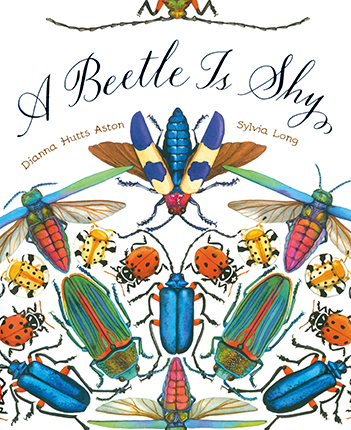| Beetle is shy Author: Aston, Dianna Hutts | ||
| Price: $6.50 | ||
Summary:
An illustrated look at the fascinating world of beetles.
| Illustrator: | Long, Sylvia |
| Accelerated Reader Information: Interest Level: LG Reading Level: 5.30 Points: .5 Quiz: 182868 | Reading Counts Information: Interest Level: K-2 Reading Level: 8.60 Points: 1.0 Quiz: 68802 | |
Reviews:
School Library Journal (05/01/16)
Booklist (04/15/16)
Full Text Reviews:
Booklist - 04/15/2016 Butterflies are showcased in many beautiful books, including A Butterfly Is Patient (2011), by Aston and Long, whose latest volume celebrates a much larger and more ancient (if not so famously decorative) group of insects: beetles. With a short paragraph on almost every page, the text addresses topics such as the egg-to-adult development of beetles, the hard outer wings that make them distinct from other insects, and their varied means of locomotion, communication, and protection. Each double-page spread leads off with a large-print line such as “A beetle is tasty,” introducing these insects as an abundant and “protein-rich” food source, or “A beetle is helpful . . . or harmful,” leading into a discussion of species that destroy pests or, alternately, destroy gardens and crops. Any thought that beetles are drab is dispelled by the large-scale watercolor illustrations, including a striking kaleidoscopelike composition that features iridescent beetle species. From the jacket art to the concluding identification page, here’s an attractive addition to the series that began with An Egg Is Quiet (2006). - Copyright 2016 Booklist.
School Library Journal - 05/01/2016 K-Gr 4—The author/illustrator pair have created yet another colorful and intricate work. The combination of Aston's soft text and Long's watercolors provide readers with an enjoyable insight into the world of beetles. Text presented in a sweeping cursive font introduces a general statement about beetles ("A beetle is telegraphic"), while text rendered in a smaller, nonscript font expands on this trait or ability ("Most beetles send messages to each other using chemicals called pheromones…. Others 'talk' to each other with squeaky, raspy sounds…"). Several illustrations depict the beetle species in their natural environments (a boll weevil munching on a plant), while others juxtapose everyday items with the insect to give a sense of size perspective (the North American featherwing beetle and the eye of a needle). Each species is labeled, and the endpapers feature an illustrated free-form list of all the beetles pictured. The only thing that could make this book better would be a glossary of the beetles with additional information for the curious child. - Copyright 2016 Publishers Weekly, Library Journal and/or School Library Journal used with permission.



